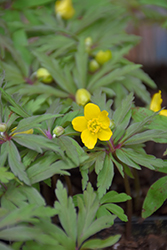Height: 6 inches
Spread: 24 inches
Sunlight:
![]()
![]()
Hardiness Zone: 4
Other Names: Buttercup Anemone, Yellow Anemone
Description:
This variety quickly forms a low spreading mat of lobed dark green foliage; produces vivid yellow buttercup flowers in early spring when little else is blooming; great for rock gardens or shaded woodland areas; dormant in summer
Ornamental Features
Yellow Wood Anemone features dainty yellow buttercup flowers with gold eyes at the ends of the stems from early to late spring. The flowers are excellent for cutting. Its lobed leaves remain green in color throughout the season.
Landscape Attributes
Yellow Wood Anemone is a dense herbaceous perennial with an upright spreading habit of growth. Its relatively fine texture sets it apart from other garden plants with less refined foliage.
This is a relatively low maintenance plant, and is best cleaned up in early spring before it resumes active growth for the season. It is a good choice for attracting bees and butterflies to your yard. It has no significant negative characteristics.
Yellow Wood Anemone is recommended for the following landscape applications;
- Mass Planting
- Rock/Alpine Gardens
- General Garden Use
- Groundcover
- Naturalizing And Woodland Gardens
Planting & Growing
Yellow Wood Anemone will grow to be only 6 inches tall at maturity, with a spread of 24 inches. Its foliage tends to remain low and dense right to the ground. It grows at a medium rate, and under ideal conditions can be expected to live for approximately 10 years. As an herbaceous perennial, this plant will usually die back to the crown each winter, and will regrow from the base each spring. Be careful not to disturb the crown in late winter when it may not be readily seen! As this plant tends to go dormant in summer, it is best interplanted with late-season bloomers to hide the dying foliage.
This plant does best in full sun to partial shade. It prefers to grow in average to moist conditions, and shouldn't be allowed to dry out. It is not particular as to soil pH, but grows best in rich soils. It is somewhat tolerant of urban pollution. This species is not originally from North America. It can be propagated by division.
